Bunker Fuel Market Size
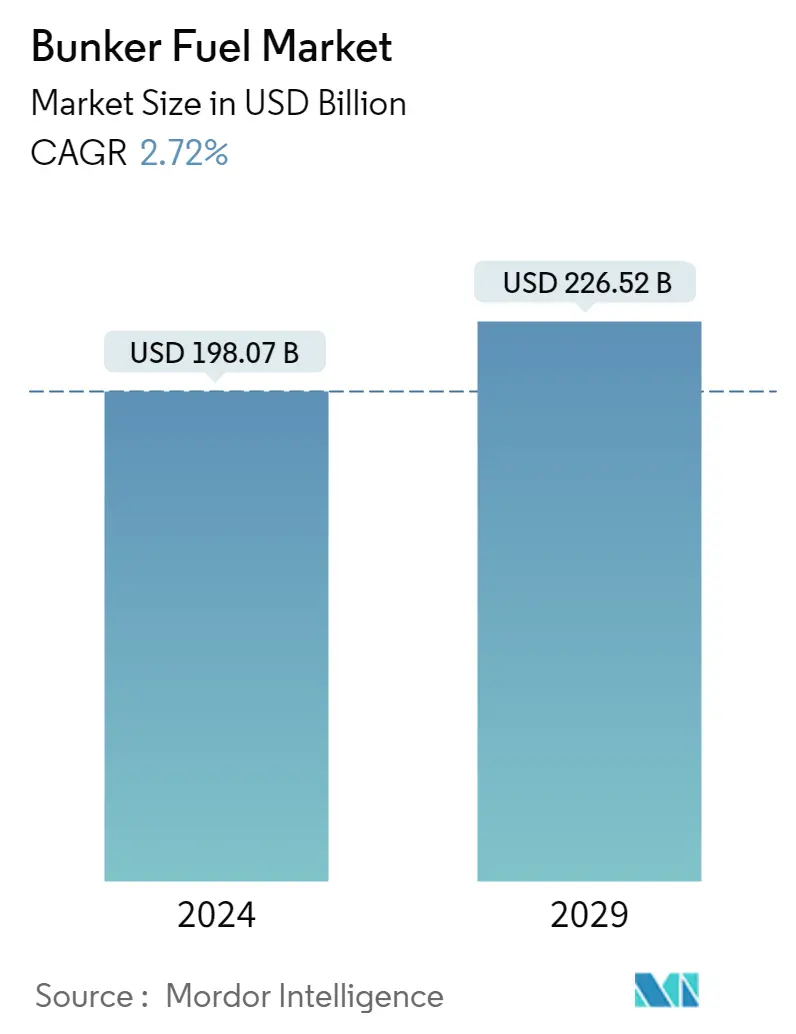
| Study Period | 2020 - 2029 |
| Market Size (2024) | USD 198.07 Billion |
| Market Size (2029) | USD 226.52 Billion |
| CAGR (2024 - 2029) | 2.72 % |
| Fastest Growing Market | Asia Pacific |
| Largest Market | Asia Pacific |
Major Players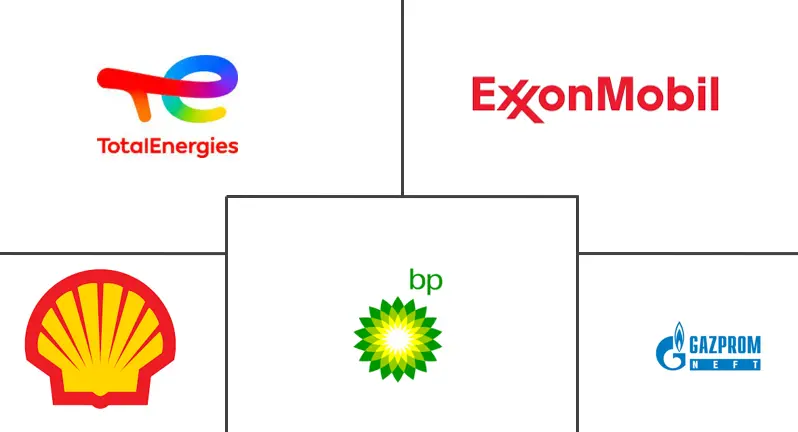
*Disclaimer: Major Players sorted in no particular order |
Bunker Fuel Market Analysis
The Bunker Fuel Market size is estimated at USD 198.07 billion in 2024, and is expected to reach USD 226.52 billion by 2029, growing at a CAGR of 2.72% during the forecast period (2024-2029).
The market was negatively impacted by COVID-19 in 2020. Presently the market has now reached pre-pandemic levels.
- Over the medium term, Increasing LNG trade is expected to increase the demand for bunker fuel. LNG is majorly traded for the power sector in industrial, commercial and residential segments. The countries with high coal dependencies, such as China and India, are gradually moving toward cleaner energy by increasing the import volume of natural gas from the Middle-east nations and few other nations, like the Russian Federation, Australia, Nigeria.
- On the other hand, the environmental concerns and the strict regulations related to emissions from maritime industry are anticipated to limit the usage of the heavy bunker fuels, especially the high Sulfur fuel oil, during the forecast period.
- Nevertheless, with the improved economic performance of developing countries in regions, such as the Asia-Pacific and the Middle-East and Africa, the demand for marine transportation and the number of ships in operation are expected to increase, offering significant growth opportunity for the bunker fuel market players in the coming years.
- Asia-Pacific is expected to dominate the market during the forecast period, with the majority of the demand coming from countries like China, India, etc.
Bunker Fuel Market Trends
LNG as a Bunker Fuel is Likely to Witness Significant Growth
- The global LNG bunkering market evolved over the past decade, driven by the growth in global LNG usage, clean energy demand, and its ability to reduce greenhouse gas emissions. The order and delivery of LNG-powered vessels are increasing, and the reduced natural gas prices in 2014 marked the beginning of expanding opportunities for such vessels.
- The conversion of the current operating vessels into LNG-based vessels is highly expensive. Hence, it is not economically viable. However, the operational cost of LNG-based vessels is expected to be least among all the fuel alternatives, once the new emission regulations become applicable. Further, a gradual shift to LNG for propulsion is more advantageous, as compared to the traditional methods of fueling ships with heavy fuel oil, marine gas oil, marine diesel oil, etc. LNG-based propulsion reduces carbon footprint significantly and increases the ship's operational efficiency.
- The LNG bunkering industry also registered significant investments in infrastructure construction, and as of January 2022, there are 33 LNG bunkering vessels and 141 LNG ports operational, and further 170 LNG ports to be expected to be operational by the end of 2022. As a result, the ship owners, particularly the ones that are operating in the European or American Sea, now prefer LNG-based vessels over conventional vessels. Furthermore, the LNG fueled ships have not penetrated the market for bulk carriers to a significant extent, as these ships are designed to carry heavy loads, and LNG technology is relatively new to apply for this type of vessels. The bulk carriers amount to the largest share of the in-operation ships.
- Furthermore, the demand for LSFO has been on the positive side due to the low sulfur restriction that has spurred demand since January 2020. Moreover, the use of LNG as a fuel is both a proven and commercially available solution. LNG offers enormous advantages, especially for ships in the light of ever-tightening emission regulations. Conventional oil-based fuels are expected to remain the primary fuel option for most ships in the mid-term, while LNG is likely to become a popular choice in the long-term scenario. In June 2022, the bunker prices for very low sulphur fuel oil (VLSFO) USD 1,043.84 per tonne (monthly average).
- For instance, in May 2022, Titan LNG and Brittany Ferries have signed a long-term bunkering agreement for the supply of LNG and Liquefied Bio Methane (LBM) to two new LNG fueled hybrid Ro-Pax vessels that Brittany Ferries is likely to operate between England and France from 2025. These vessels are expected to serve established routes connecting Portsmouth with Saint-Malo, and Portsmouth with Ouistreham. Also, Titans aims to supply fuel to both vessels during usual cargo operations alongside SIMOPS (simultaneous operations).
- The LNG demand is likely to increase significantly in the forecast period as the orderbook for LNG vessels continues to increase, relatively cheaper than conventional fuels, offers 23% cut in greenhouse gas emissions over oil-based marine fuel which will aid to meet the global decarbonization goals making it the most popular marine fuel in the future.
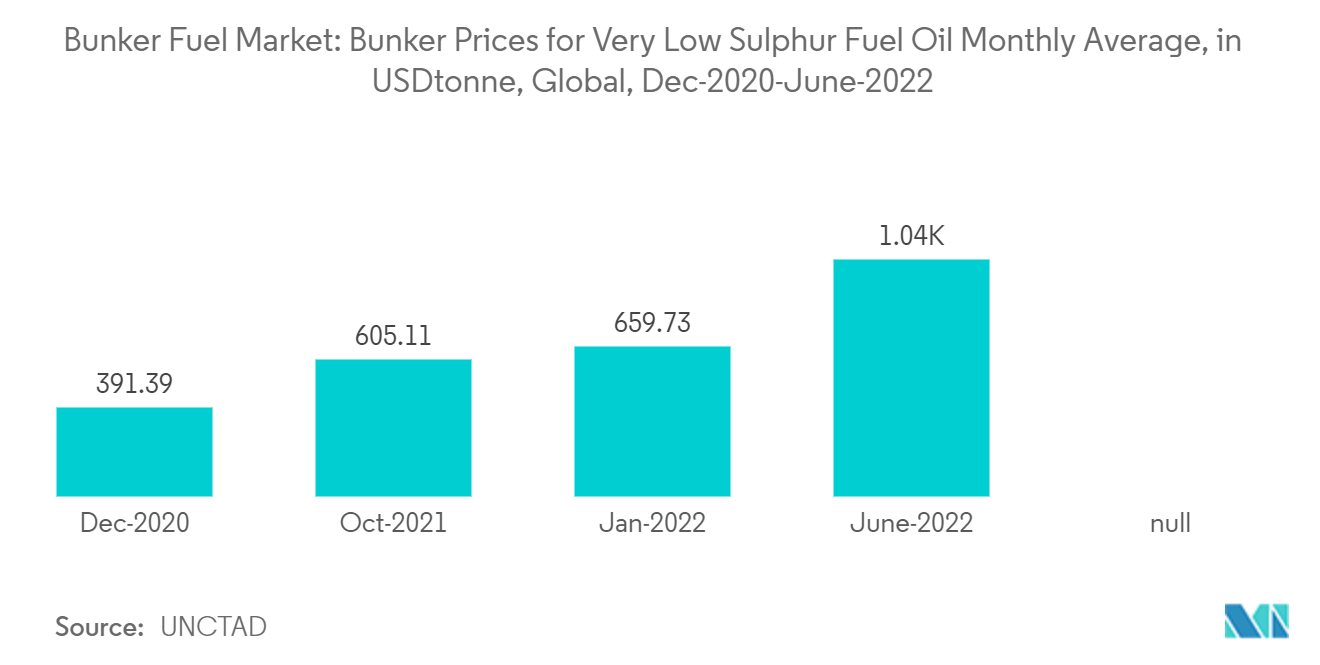
Asia-Pacific is Expected to Dominate the Market
- Asia-Pacific is expected to dominate the bunker fuel market due to the immense maritime trade potential of countries like India, China, Singapore, Japan, and other countries.
- As of 2022, China ranks first for exporter goods and second for imported goods by value. China's major exports are mechanical and electric machinery and equipment, automotive products, including vehicle parts, chemicals and plastics, iron and steel articles, furniture, etc.
- Further, the fleet in the country is registering a situation of drastic oversupply. According to the Ministry of Transport of the People's Republic of China, in 2021, Shanghai port topped in the container throughput, reaching over 47.03 million TEU witnessing an increase of 8.1% compared to 2020 levels.
- Australia is among the biggest exporter of LNG globally. The rising LNG exports supported the international trade of Australia.The export volume is likely to go up in the coming years as the demand for LNG is increasing significantly across the globe.
- To increase the share of the marine sector in international and domestic trade, the Indian government announced an investment of USD 22 billion by 2035 to modernize the existing ports and build new ports. The port infrastructure development is expected to increase the demand from the maritime industry and marine fuel suppliers in Asia-Pacific during the forecast period.
- In March 2022, the first marine bio-VLSFO (very low sulfur fuel oil) bunker delivery was carried out by TotalEnergies Marine Fuels at Singapore port's waters. The delivery was part of NYK Line and Anglo American's recently completed biofuel trial. The delivery was supplied to the MT Friendship via a ship-to-ship transfer and consisted of a B10 biofuel blend made up of VLSFO blended with 10% second-generation, waste-based and ISCC-certified UCOME (used cooking oil methyl ester). The biofuel was used during the vessel's two-way trip between Singapore and Saldanha Bay in South Africa.
- Therefore, based on the aforementioned factors, Asia-Pacific is expected to dominate the bunker fuel market during the forecast period.
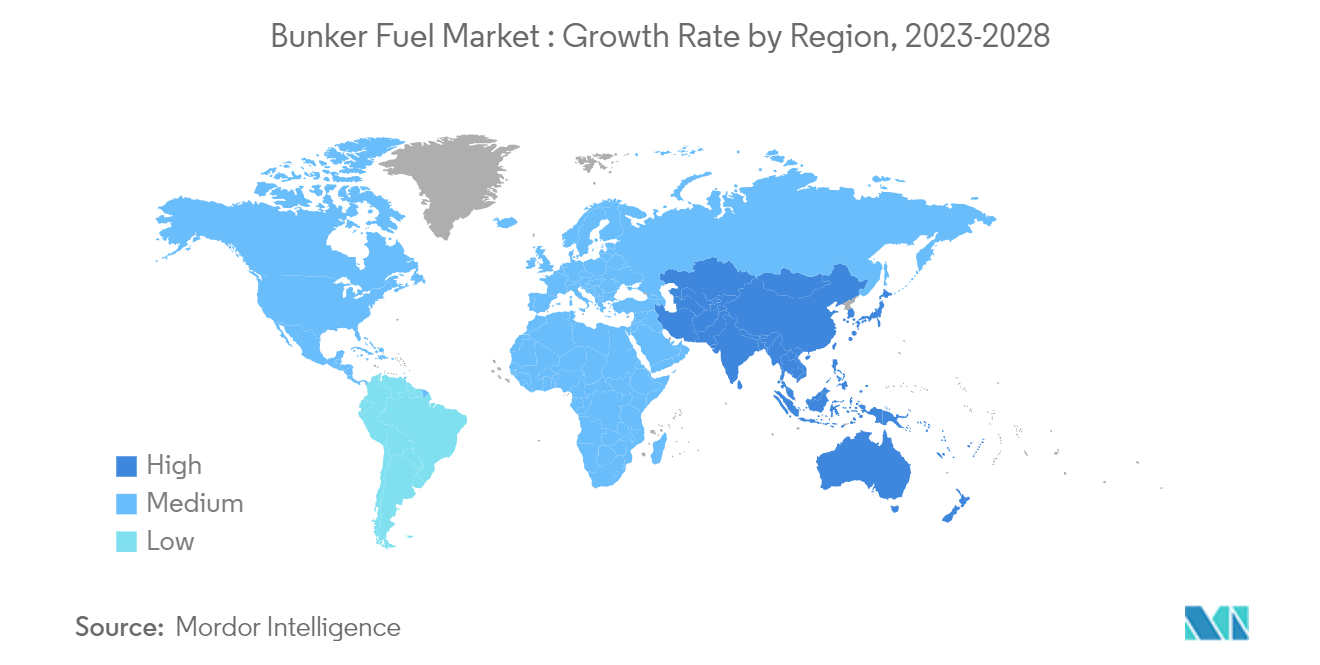
Bunker Fuel Industry Overview
The bunker fuel Market is fragmented in nature. Some of the major players in the market (in no particular order) include Gazpromneft Marine Bunker LLC, ExxonMobil Corporation, Shell PLC, TotalEnergies SE, and BP PLC among others.
Bunker Fuel Market Leaders
-
Exxon Mobil Corporation
-
BP Plc
-
Royal Dutch Shell Plc
-
Gazpromneft Marine Bunker LLC
-
TotalEnergies SE
*Disclaimer: Major Players sorted in no particular order
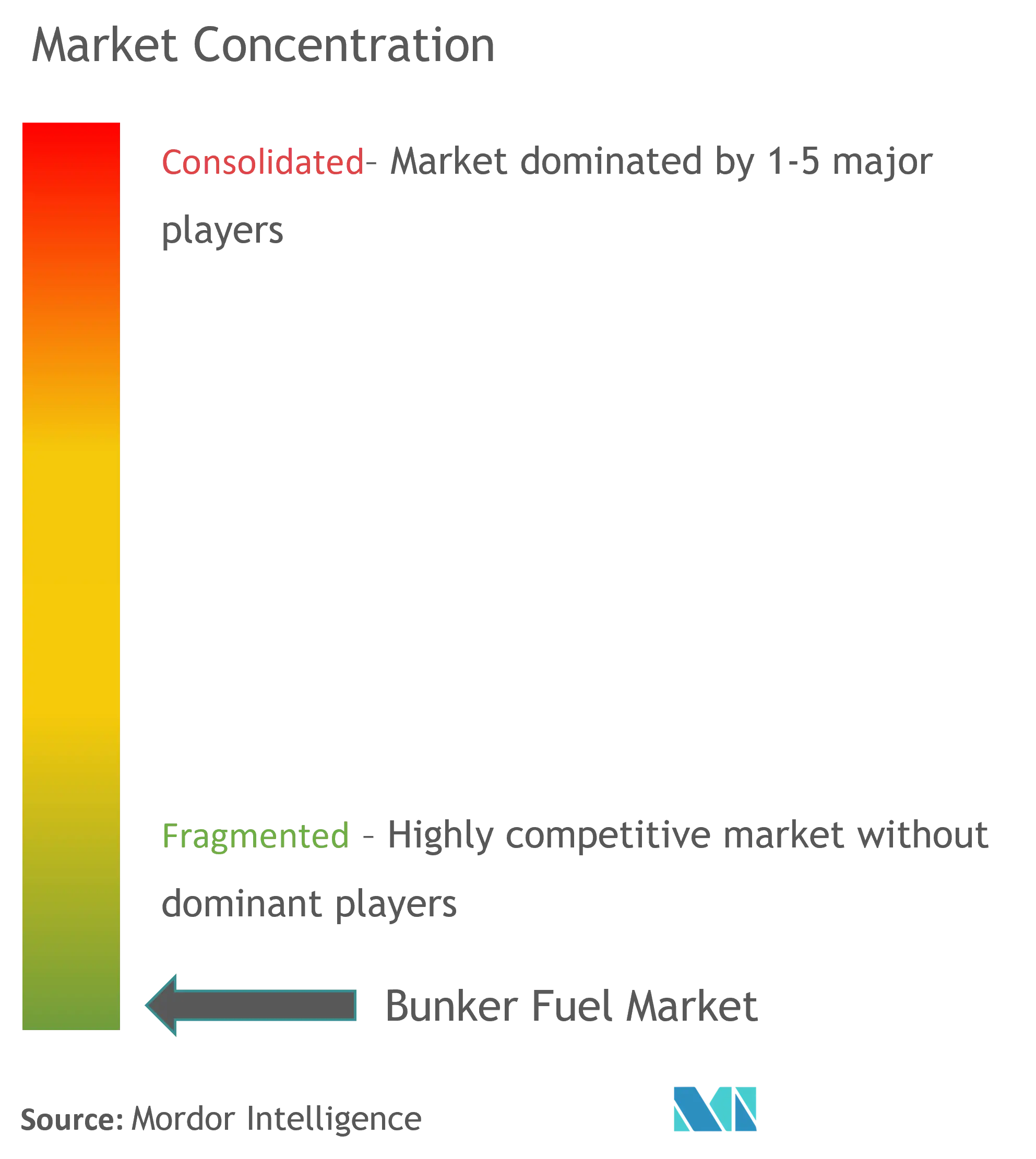
Bunker Fuel Market News
- In January 2022, Titan LNG secured the tender for the delivery of LNG in the Port of Marseille for Corsica Linea's new Ro-Pax LNG fueled ferry. This partnership indicates the expansion of Titan LNG's operation into the Mediterranean that will enhance the availability of LNG, bioLNG, and in the longer run, hydrogen-derived LNG in the region.
- In November 2022, Nimofast BrasilS.A, the natural gas trader, has signed a partnership agreement with the Norwegian company KanferShipping AS in which Nimofast will provide small and medium-scale LNG shipping, small-scale floating storage units (FSU) and LNG bunkering solutions for Kanfer'sclients in Brazil.
Bunker Fuel Market Report - Table of Contents
1. INTRODUCTION
- 1.1 Scope of the Study
- 1.2 Market Definition
- 1.3 Study Assumptions
2. EXECUTIVE SUMMARY
3. RESEARCH METHODOLOGY
4. MARKET OVERVIEW
- 4.1 Introduction
- 4.2 Market Size and Demand Forecast in USD billion, till 2028
- 4.3 Recent Trends and Developments
- 4.4 Government Policies and Regulations
-
4.5 Market Dynamics
- 4.5.1 Drivers
- 4.5.1.1 Increased LNG Trade Worldwide
- 4.5.1.2 Increasing Dependecies over Natural Gas for Power Generation
- 4.5.2 Restraints
- 4.5.2.1 Environmental Concerns and the Strict Regulations Related to Emissions from Maritime Industry
- 4.6 Supply Chain Analysis
-
4.7 Porter's Five Forces Analysis
- 4.7.1 Bargaining Power of Suppliers
- 4.7.2 Bargaining Power of Consumers
- 4.7.3 Threat of New Entrants
- 4.7.4 Threat of Substitute Products and Services
- 4.7.5 Intensity of Competitive Rivalry
5. MARKET SEGMENTATION
-
5.1 Fuel Type
- 5.1.1 High Sulfur Fuel Oil (HSFO)
- 5.1.2 Very Low Sulfur Fuel Oil (VLSFO)
- 5.1.3 Marine Gas Oil (MGO)
- 5.1.4 Liquefied Natural Gas (LNG)
- 5.1.5 Other Fuel Types
-
5.2 Vessel Type
- 5.2.1 Containers
- 5.2.2 Tankers
- 5.2.3 General Cargo
- 5.2.4 Bulk Carriers
- 5.2.5 Other Vessel Types
-
5.3 Geography
- 5.3.1 North America
- 5.3.1.1 United States
- 5.3.1.2 Canada
- 5.3.1.3 Rest of North America
- 5.3.2 Europe
- 5.3.2.1 Germany
- 5.3.2.2 France
- 5.3.2.3 United Kingdom
- 5.3.2.4 Rest of Europe
- 5.3.3 Asia-Pacific
- 5.3.3.1 China
- 5.3.3.2 India
- 5.3.3.3 Japan
- 5.3.3.4 South Korea
- 5.3.3.5 Rest of Asia-Pacific
- 5.3.4 South America
- 5.3.4.1 Brazil
- 5.3.4.2 Argentina
- 5.3.4.3 Rest of South America
- 5.3.5 Middle-East and Africa
- 5.3.5.1 Saudi Arabia
- 5.3.5.2 United Arab Emirates
- 5.3.5.3 South Africa
- 5.3.5.4 Rest of Middle-East and Africa
6. COMPETITIVE LANDSCAPE
- 6.1 Mergers and Acquisitions, Joint Ventures, Collaborations, and Agreements
- 6.2 Strategies Adopted by Leading Players
-
6.3 Company Profiles
- 6.3.1 Fuel Suppliers
- 6.3.1.1 ExxonMobil Corporation
- 6.3.1.2 Shell PLC
- 6.3.1.3 Gazpromneft Marine Bunker LLC
- 6.3.1.4 BP PLC
- 6.3.1.5 PJSC Lukoil Oil Company
- 6.3.1.6 TotalEnergies SE
- 6.3.1.7 Chevron Corporation
- 6.3.1.8 Clipper Oil
- 6.3.1.9 Gulf Agency Company Ltd
- 6.3.1.10 Bomin Bunker Holding GmbH & Co. KG
- 6.3.2 Ship Owners
- 6.3.2.1 AP Moeller Maersk AS
- 6.3.2.2 Mediterranean Shipping Company SA
- 6.3.2.3 China COSCO Shipping Corporation Limited
- 6.3.2.4 CMA CGM Group
- 6.3.2.5 Hapag-Lloyd AG
- 6.3.2.6 Ocean Network Express
- 6.3.2.7 Evergreen Marine Corp Taiwan Ltd
- 6.3.2.8 Yang Ming Marine Transport Corporation
- 6.3.2.9 HMM Co. Ltd
- 6.3.2.10 Pacific International Lines Pte Ltd
- *List Not Exhaustive
7. MARKET OPPORTUNITIES AND FUTURE TRENDS
- 7.1 Risisng Demand for Marine Transportation and Increasing Number of Ships in Operation
Bunker Fuel Industry Segmentation
Bunker fuel is the general term given to any fuel poured into a ship's bunkers to power its engines. Deep-sea cargo ships typically burn the heavy, residual oil left over after gasoline, diesel, and other light hydrocarbons that are extracted from crude oil during the refining process. The bunker fuel market is segmented by fuel type, vessel type, and geography. By fuel type, the market is segmented into high sulfur fuel oil (HSFO), very low sulfur fuel oil (VLSFO), marine gas oil (MGO), liquefied natural gas (LNG), and other fuel types. By vessel type, the market is segmented into containers, tankers, general cargo, bulk carriers, and other vessel types. The report also covers the market size and forecasts for the Bunker Fuel market across major regions. For each segment, the market sizing and forecasts have been done based on revenue (USD billion).
| Fuel Type | High Sulfur Fuel Oil (HSFO) | |
| Very Low Sulfur Fuel Oil (VLSFO) | ||
| Marine Gas Oil (MGO) | ||
| Liquefied Natural Gas (LNG) | ||
| Other Fuel Types | ||
| Vessel Type | Containers | |
| Tankers | ||
| General Cargo | ||
| Bulk Carriers | ||
| Other Vessel Types | ||
| Geography | North America | United States |
| Canada | ||
| Rest of North America | ||
| Geography | Europe | Germany |
| France | ||
| United Kingdom | ||
| Rest of Europe | ||
| Geography | Asia-Pacific | China |
| India | ||
| Japan | ||
| South Korea | ||
| Rest of Asia-Pacific | ||
| Geography | South America | Brazil |
| Argentina | ||
| Rest of South America | ||
| Geography | Middle-East and Africa | Saudi Arabia |
| United Arab Emirates | ||
| South Africa | ||
| Rest of Middle-East and Africa |
Bunker Fuel Market Research FAQs
How big is the Bunker Fuel Market?
The Bunker Fuel Market size is expected to reach USD 198.07 billion in 2024 and grow at a CAGR of 2.72% to reach USD 226.52 billion by 2029.
What is the current Bunker Fuel Market size?
In 2024, the Bunker Fuel Market size is expected to reach USD 198.07 billion.
Who are the key players in Bunker Fuel Market?
Exxon Mobil Corporation, BP Plc, Royal Dutch Shell Plc, Gazpromneft Marine Bunker LLC and TotalEnergies SE are the major companies operating in the Bunker Fuel Market.
Which is the fastest growing region in Bunker Fuel Market?
Asia Pacific is estimated to grow at the highest CAGR over the forecast period (2024-2029).
Which region has the biggest share in Bunker Fuel Market?
In 2024, the Asia Pacific accounts for the largest market share in Bunker Fuel Market.
What years does this Bunker Fuel Market cover, and what was the market size in 2023?
In 2023, the Bunker Fuel Market size was estimated at USD 192.83 billion. The report covers the Bunker Fuel Market historical market size for years: 2020, 2021, 2022 and 2023. The report also forecasts the Bunker Fuel Market size for years: 2024, 2025, 2026, 2027, 2028 and 2029.
What are the key trends driving the global Bunker Fuel Market?
The key trends driving the global Bunker Fuel Market are a) Rise in international seaborne trade b) Increase in offshore exploration & production activities c) Surge in demand for LNG bunkering
Bunker Fuel Industry Report
The global bunker fuel market is experiencing significant growth, driven by diverse factors across various segments and regions. The market is segmented by type, commercial distributor, and application, addressing the varied needs of the maritime industry. Types of bunker fuel include high sulfur fuel oil, low sulfur fuel oil, marine gas oil, among others, with low sulfur variants increasingly favored due to strict environmental regulations. Commercial distributors are categorized into oil majors, large independents, and small independents, with oil majors leading due to their extensive crude oil tanker chartering operations. Applications cover container ships, bulk carriers, oil tankers, and more, with container shipping in high demand due to rising global trade activities. Regionally, the Asia-Pacific market dominates in bunker fuel consumption, driven by significant maritime trade activities and the presence of major shipping nations like China, Japan, and Singapore. Additionally, the market is influenced by the increase in international seaborne trade and a shift towards cleaner energy sources like LNG. The bunkering industry is adapting to changing regulatory landscapes and energy demands, ensuring sustained growth through strategic investments and expansions in key maritime hubs. For detailed statistics, market share, size, and revenue growth rates, access a free report PDF download from Mordor Intelligence™ Industry Reports.



